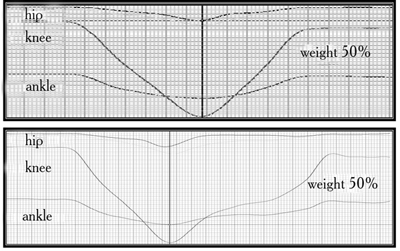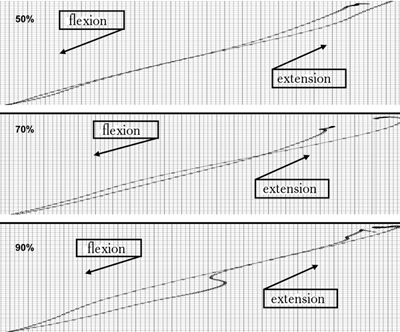Changes of kinematic characteristics when doing squats in power lifting
Фотографии:
ˑ:
K.D. Chermit, professor, Dr.Hab., Dr.Biol.
A.G. Zabolotniy, Ph.D.
Adyghe state university, Maikop
Key words: kinematic structure, powerlifting, front squat.
Introduction. Improvement of the methodology of training when doing a front squat in powerlifting is inseparably related linked with the acquisition and use of objective information about the mechanism of motion control when working with weights [1-3]. External manifestation of the control mechanism is determined by the motor kinematic structure, characterizing the spatiotemporal order of move in the kinematic chains of the human musculoskeletal system due to the need to achieve the desired result. The study of kinematic characteristics will help to determine the variability of the kinematic structure and to define the criteria of the quality of performance of motor action. The system of motion video analysis is an objective method for studying kinematic characteristics, which contributes to studies of the human movement during a front squat.
The purpose of the study was to analyze changes in kinematic characteristics when performing squats in powerlifting.
Materials and methods. The kinematic characteristics of front squat were examined in the laboratory of ergonomic biomechanics of the center "Health" of ASU. The experiment involved 16 athletes. The subjects performed front squat with weights 50, 60, 70, 80, 90 %. Kinematic characteristics were recorded using the optical system of three-dimensional video analysis of movements. The hardware part of the complex "Motion video analysis" consists of two video cameras, two backlights, test object; retroreflective markers, computer, video capture card, recording video on a hard drive. Made videos were processed using the Software Complex Video Motion_ 3D.
The software part of the complex is responsible for the following operations:
- records video of movements with the rate 50 frame/s;
- processes automatically marker coordinates on the human body;
- presents in the graphical form all fixed kinematic information.
Results and discussion. Front squat is made using angular displacement in hip, knee and ankle joints. Given the orientation of these movements motor action can be divided into two phases: lowering into a squat and rising from a squat. There were studied the temporal limits of the motor action and the duration of selected phases when working with weights from 50 to 90%. The studies have revealed the increase of the duration of the phase of rise from a squat when working with weights close to maximum (80, 90%), resulting in more time spent for a motor action (Tab. 1). The duration of the phase lowering into a squat does not change for all used weights.
Table 1. Time parameters of front squats with weights from 50 to 90% of the maximum
|
Time parameters |
Weight, % |
||||
|
50 |
60 |
70 |
80 |
90 |
|
|
Time of performance of motor action |
2,56±0,25 |
2,66±0,34 |
2,94±0,29 |
3,26±0,33 |
3,66±0,32* |
|
Time of squat |
1,27±0,12 |
1,33±0,13 |
1,32±0,13 |
1,44±0,2 |
1,41±0,21 |
|
Time of rising |
1,26±0,14 |
1,32±0,20 |
1,62±0,21 |
1,82±0,21* |
2,25±0,21** |
|
Rate |
1,007 |
1,007 |
0,81 |
0,79 |
0,62 |
* – significance of differences р<0,05,
** – significance of differences р<0,001.
Changing of time parameters of a motor action determines the need to examine the magnitude and the dynamics of angular displacement in the studied joints. The displacement angle at active knee joint is 123±9,2º, ankle – 57±7,2º, at flexion/extension of hip joint – 26±5,7º, and at its abduction/ adduction – 14,8 ± 8,9º. The dynamics of angular displacement was studied by analyzing their graphic representation in joints (Fig. 1). It has been found that the graphic representation of change in the angles in joints when using 50-60% weights visually represents the geometric parabola, the left branch of which characterizes flexion in a joint, and the right - extension. In accordance with the principles of construction of a parabola the time sequence of extension in joint is a reverse sequence of flexion. The accuracy of the manifestation of this dependence increases with the approach of the moment of changing from flexion to extension; the graph shows that in the area of approach of branches of the parabola to its breakpoint. The accuracy of this dependence is reduced at the moment of transition from the initial position to the beginning of the implementation of motor action and the transition of the final motor action to the final position. On the graph of Fig. 1 it is noted in the moment of maximum divergence of the parabola branches.

Fig. 1. Angular displacements in hip, knee and ankle joints when doing a front squat with weights 50 and 90%
The reverse time sequence of the transition from extension in joints to flexion is found in all subjects when working with 50 and 60 % weights. It should be noted that it is not a question of absolute, mathematically precise manifestation of it. It is a matter of its primary manifestation, which is most close to absolute. The greatest approach to the mathematically precise manifestation of this dependence is typical for angular displacement in knee joint.
An increase of weight up to 70 and then to 80 and 90% leads to disruption of the reverse time sequence of extension in joint to flexion; on the graph on Fig. 1 it is shown in spreading the middle of the right branch of the parabola in the horizontal direction, which indicates an increase in the time of joint extension. The more the weight is, the more clearly this trend is seen. The identified changes do not affect the initial period of extension, where the inverse nature of extension relative to the flexion persists.
Thus, the manifestation of the inverse dependence of flexion towards extension during angular displacement in a joint serves as a quality criterion of performance of motor action. The graphic presentation of changes in joint angles in this case visually represents a symmetric parabola. The defect in the quality of performance of motor action when applying weights close to maximum is shown on the graph (Fig. 1) in the change of the right branch of the parabola that characterizes the process of extension of joints keeping the shape of the left branch characterizing flexion.
The consistency of angular displacements is an important criterion for a qualitative assessment of motor action. To determine the consistency graphic figures of angular synkineses of knee and ankle, knee and hip, hip and ankle joints were studied during a front squat with weights from 50 to 90%. In order to make graphic figures the parameters of angular displacements of the selected pair of joints were set aside on various axes, and then a graph of angular synkinesis - dependence of angular displacement in one joint relative to another was built. Synkineses that we interpret as associated movements in the structure of a motor act are a part of synergies, i.e. joint coordinated contractions of various muscle groups, ensuring the implementation of a motor action. They are of great importance in the mechanisms of maintaining posture and body balance. The consistency of muscle groups while ensuring the interaction of various parts of the central nervous system - somatic motor and extrapyramidal systems, cerebellum, segmental apparatus of the spinal cord.
Angular synkinesis is a consistency of angular displacements of joints, providing performance of a motor action. Graphical representation of angular synkeneses of flexion and extension of knee and ankle joints when working with 50% and 60% weights is a conditional straight line that at the extreme point has a reversed direction. The obtained branches of the graph for all subjects preferably coincide or are parallel, their discrepancy is possible at the beginning and at the end of extension (Fig. 2). In this regard, we can conclude that coordinated angular displacements in the mechanism of implementation of a motor action are displayed on the graph in matching conditional straight lines, characterizing flexion and extension of joints.

Fig. 2. Angular synkineses of work of knee and ankle joints in a front squat with 50, 70 and 90% weights
The increase of weight up to 70, 80 % leads to a change in the form of direct dependence of angular displacement in extension of joints, which is shown in its distance from the direct dependence of angular displacements at flexion. We consider a mismatch of straight lines as a first sign of coordinated work of joints. In a motor action it is shown in the advance of extension of ankle joint relative to knee joint.
Distancing of the direct dependence of angular displacements in joint extension from the direct dependence of angular displacements at flexion increases at 90% weights. Reaching the point of maximum divergence, the straight line of extension is refracted toward the line of flexion, and upon achieving it both of the straight lines coincide and then do not move away significantly from each other for a considerable distance. The refraction point of the direct dependence of angular displacements at extension of knee and ankle joints is a place of the maximum mismatch in their work. The reason of mismatch is advance in velocity of extension of the ankle joint in relation to the knee joint. Further performance of motor actions requires the restoration of consistence of angular displacements, which is carried out by the inhibition of angular displacement or by the backward motion of an ankle joint. Studying of the graphic figures of angular synkineses of knee and hip, hip and ankle joints confirms the foregoing.
The parameters of angular velocity and angular acceleration were studied, along with their relationships in the studied joints when the front squat is 50, 60, 70, 80 and 90%. The ratios were determined by establishing percentages, angular velocity and angular acceleration in the mechanism of motor action. The findings testified to the reduced velocity of extension of joints when working with weights close to maximum (90%), and the parameters of angular acceleration and velocity of flexion of joints remain stable when using all weights (Tab. 2).
Table 2. Angular velocity and angular acceleration of joint flexion and extension when making a front squat with weights from 50 to 90%
|
Parameters |
Amount of weight, % |
|||||
|
50 |
60 |
70 |
80 |
90 |
||
|
Hip, flexion/extension |
AV flex., rad/s |
18,1±3,5 |
17,3±4 |
18,1±3,5 |
16,7±4 |
15,8±2,1 |
|
AV ext., rad/s |
19,18±3,3 |
17,58±4,4 |
16,16±3,8 |
13,56±3,1 |
10,14±1,5 * |
|
|
AA flex., rad/s² |
63,3±11 |
59,32±10 |
59,38±11 |
56,48±11 |
53,24±6 |
|
|
AA ext., rad/s² |
67,1±8 |
62,46±12 |
62,36±10 |
60,42±9 |
53,52±4,8 |
|
|
Knee |
AV flex., rad/s |
91,8±8,5 |
90,1±8,8 |
88,08±9,6 |
79,5±6,6 |
77,3±6,6 |
|
AV ext. rad/s |
92,58±12,5 |
86,16±12 |
70,12±13 |
61,94±8 |
45,7±6* |
|
|
AA flex., rad/s² |
250,86±33,8 |
212,44±42,6 |
218,4±66,3 |
192,8±51 |
156,04±40 |
|
|
AA ext., rad/s² |
235,92 |
214,06 |
190,56 |
189,6 |
159,3 |
|
|
Ankle |
AV flex., rad/s |
28,5±4,9 |
27,3±4,4 |
29,01±5,6 |
25,5±4,2 |
24,7±4,1 |
|
AV ext., rad/s |
28,7±4,5 |
25,04±5,3 |
21,5±5,8 |
19,76±4,1 |
15,7±4,2* |
|
|
AA flex., rad/s² |
90,6±12 |
78,7±24 |
99,2±14 |
89,2±25 |
64,2±15 |
|
|
AA ext. rad/s² |
80,8±11 |
65,6±18 |
61,175±12 |
69,1±16 |
59,4±12 |
|
AV – angular velocity,
AA – angular acceleration,
* – significance of differences at р<0,05.
The ratio of the shares of velocity of angular displacement when flexing and extending joints remains unchanged for all weights (Tab. 3). The share of velocity of angular displacement in the mechanism of implementation of motor action at hip joint extension ranges from 14 to 15%, and at flexion - 13-14% for all weights. The share of velocity of angular displacement at knee joint extension varies between 64-67%, and at flexion - 65-67%, the share of velocity of angular displacement at extension of ankle joint - within 19-22%, and at flexion - 20-21%. The ratio of the percentages of angular acceleration of examined joints, as well as angular velocity remains the same when using all applicable weights.
Table 3. The ratio of shares of angular velocity of displacement in joints when doing a front squat with weights from 50 to 90%
|
Amount of weight, % |
|
|||||
|
Extension of joints |
Flexion of joints |
|||||
|
hip |
knee |
ankle |
hip |
knee |
ankle |
|
|
|
|
|
Shares of angular velocity, % |
|
|
|
|
50 |
14 |
66 |
20 |
13 |
66 |
21 |
|
60 |
14 |
67 |
19 |
13 |
67 |
20 |
|
70 |
15 |
65 |
20 |
13 |
66 |
21 |
|
80 |
14 |
65 |
21 |
14 |
65 |
21 |
|
90 |
14 |
64 |
22 |
13 |
66 |
21 |
|
|
Shares of angular acceleration, % |
|||||
|
50 |
17 |
62 |
21 |
16 |
62 |
22 |
|
60 |
18 |
63 |
19 |
17 |
61 |
22 |
|
70 |
20 |
61 |
19 |
15 |
58 |
26 |
|
80 |
19 |
59 |
22 |
17 |
57 |
26 |
|
90 |
20 |
58 |
22 |
19 |
58 |
23 |
|
50 |
17 |
62 |
21 |
16 |
62 |
22 |
Conclusion. The study of kinematic characteristics in front squat with different weights enables to conclude that the quality criteria of performance of a front squat are: reverse temporal order of angular displacement in hip, knee and ankle joints at extension towards flexion; consistency of angular displacement in hip, knee and ankle joints, lack of significant differences between velocity of angular displacement at flexion and extension of hip, knee and ankle joints; lack of significant differences in time of angular displacement at flexion and extension of hip, knee and ankle joints.
Conclusions
1. The temporal character of front squat is determined by the duration of phases of lowering into a squat and rising from a squat. The stability of these temporal characteristics is observed before using 70 % weight. The increase of weight up to 80 and 90 % of the maximum leads to longer implementation of movement by increasing the duration of the phase of rising from a squat.
2. The temporal order of extension of knee, hip and ankle joints when using 50-60% weights is an inverse to that at flexion of these joints. The graphical representation of angular displacement is a geometric parabola, its left branch characterizes flexion of joint, and the right - extension. The increase of weight up to 70, 80 and 90% leads to disturbance of this dependence.
3. Consistency of angular displacements of joints, providing performance of a motor action, remains when using weights in 50-60%. The first signs of its disturbance are observed on the graphs of angular synkineses when increasing weight up to 70-80%, at 90 % weight the disturbance of consistency already requires correction of angular displacement. The reason of consistency violation is an advance of extension of one joint relative to another. The consistency is restored by slowing down the angular displacement or by the return movement in one of the joints.
4. A change of spatiotemporal kinematic characteristics is defined by:
- stability of velocity of angular displacement at flexion and extension of joints prior to using 80% weights;
- decrease of velocity of joint extension preserving the velocity of flexion using 90% weights;
- stability of parameters of angular acceleration in knee, hip and ankle joints for all used weights;
- stability of shares of velocity of angular displacement in knee, hip and ankle joints at flexion and extension (for all weights)
References
- Chermit, K.D. The electromyographic characteristic of squat in powerlifting / K.D. Chermit, A.V. Shakhanova, A.G. Zabolotniy, A.A. Tkhagova // Vestnik Adygeyskogo gosudarstvennogo universiteta: quarterly scientific journal. Ser. ‘Natural sciences”. - Maikop, 2011. – № 4. (In Russian)
- Chermit, K.D. Classification of muscle bioelectric activity when doing a front squat in powerlifting / K.D. Chermit, A.G. Zabolotniy, A.V. Shakhanova, A.A. Tkhagova // Vestnik Adygeyskogo gosudarstvennogo universiteta: quarterly scientific journal. Ser. ‘Natural sciences”. - Maikop, 2012. – № 1. (In Russian)
- Chermit K.D. Sports lateral stress (ports statement) 12th International Scientific Conference of Sport Kinetics 2011. “Present and Future Research in the Science of Human Movement”. University School of Physical Education in Krakow. Krakow, 2011. P. 148.
Author's contacts: chermit@adygnet.ru


